 |
 |
| French Overseas Department and Territories ESSAI (pattern) coins |
|
Nine French
Overseas Departments and Territories including
French communes had made a series of Proof Essai
(Pattern) coins released in 2004 for each of them individually. In this
joint project, each of the territory released three
pattern coins: a silver 1/4 Euro, a crown-sized silver 1 1/2 Euro and a 1/4
ounce gold 20 Euro.
The Gold 20 Euro coins are hand struck and each contains 1/4 troy ounce of gold. They are 27mm in diameter. Each coin features an important native animal on one side and the territorial arms on the other. The revised mintage on the gold has been dropped to only 50 pieces of each type, making them an unbelievable rarity. Because each coin is individually hand struck, minor imperfections may be encountered. The silver 1 1/2 Euro coins commemorate the history of the French Navy. Each coin features a famous ship on one side of the coin, the territories arms on the other. Each coin is 38mm in diameter and contains 1 ounce of .999 fine silver. They have a mintage of only 2000 Pieces each. The silver 1/4 Euro coins commemorate French Medalist and coin designer Louis Oscar Roty. Roty lived from 1846 to 1911. He was a prolific sculpture and engraver. His works can be found in most major European museums. He is probably best remembered for his 1898 engravraving of "Semeuse (the Sower) which graced French coins for nearly a century. The obverse of each coin features his portrait and the name of the territory. The reverse features a beautiful rendition of one of his works on the other. The coins are 27mm in diameter and contain 1/4 ounce of .999 silver. There is a mintage of only 2000 pieces of each type. Each coin is graded Fleur-de-Coin (FDC) in French standards, and is Proof or Proof-like in American grading standards. These coins were released approximately one every week or two until the series was at last complete. I got my silver 1 1/2 Euro set from Joel Anderson and these coins can also be viewed on his website at: http://www.joelscoins.com/frenchterr.htm. Because most of these territories have issued few, if any coins, It is expected to be very popular. |
|
| FRENCH GUYANA | |
 |
|
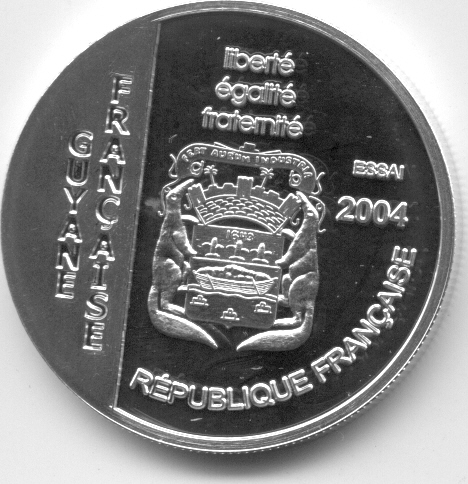 |
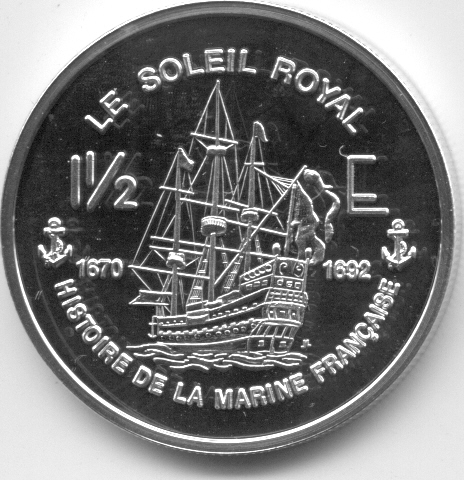 |
| It is French Overseas Department since 1946, located on the northern coast of South America. French Guiana is also a région (région d'outre-mer) of France. As a part of France, French Guiana is in the European Union. Since European settlement by the French in 1604, French Guiana was the site of notorious penal settlements (Devil's Island) until 1951. French Guiana was originally inhabited by a number of Native American peoples, among them the Carib, Arawak, Emerillon, Galibi, Palikour, Wayampi (also known as Oyampi) and Wayana.In 1498 French Guiana was first visited by Europeans when Christopher Columbus sailed to the region and reportedly named it the "Land of pariahs". The early 1600's saw attempts by the French and Dutch to settle in the area, though they faced difficulties in the face of Amerindian hostility and widespread tropical diseases. In 1643 the French managed to establish a settlement at Cayenne along with some small-scale plantations, however this was attacked by Amerindians. The French later re-established it in the 1660's, along with another settlement at Sinnamary (this was attacked by the Dutch in 1665). In 1667 the British seized the area. Following the Treaty of Breda on 31st July 1667 the area was given back to France. The Dutch briefly occupied it for a period in 1676. The silver 1 1/2 Euro portrays the Louis XIV’s flagship the Soleil Royal. The 104 gun ship was launched in the late 17th century to join the relentless battles between the French, Dutch, English and Spanish over domination of the oceans. After successful battles against the British and Dutch, she was burned while beached for repairs in 1792 to avoid capture. This coin has a reeded edge. | |
| FRENCH SOUTHERN AND ANTARCTIC TERRITORIES | |
 |
|
 |
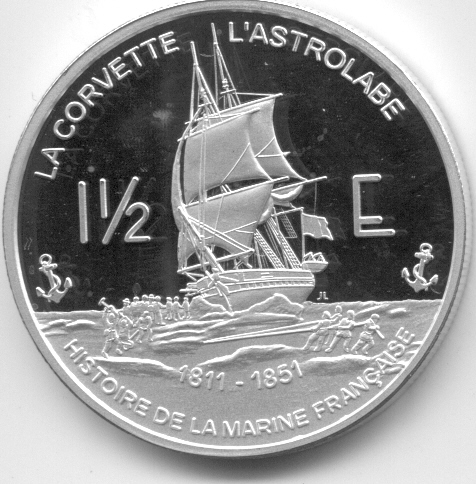 |
| It is a French Overseas Territory since 1956 and known as Terres Australes et Antarctiques Françaises (TAAF), this territory consists of several groups of islands in the southern Indian Ocean and a sector of Antarctica that is claimed by France. The territory is inhabited by a few researchers and many Penguins. The territory is divided into four districts. Amsterdam and Saint Paul (Îles Saint Paul et Amsterdam), composed of Île Amsterdam and Île Saint-Paul, area 61 km², main base Martin-de-Viviès. Crozet Archipelago (Îles Crozet or officially Archipel Crozet), area 505 km², main base Alfred-Faure. Kerguelen (Îles Kerguelen or officially Archipel (des) Kerguelen), area 7,215 km², main base Port-aux-Français. Adélie Land (Terre Adélie), area 432,000 km², main base Dumont d'Urville. Each district is headed by a district chief, which has powers similar to those of a French mayor (including recording births and deaths and being an officer of judicial police). Because there is no permanent population, there is no elected assembly, nor does the territory send representatives to the national parliament. Several countries do not recognize the French claim to "Adélie Land", and France's territorial claim is suspended in accordance with the provisions of the Antarctic Treaty. As of 2005, the inclusion of the Scattered Islands into the TAAF is being considered by the French government. The prefect of the TAAF has already been put in charge of those islands. The silver 1 1/2 Euro shows the crew of the sailing ship L'Astrolabe trying to extract it from Antarctic sea ice. The obverse features the arms of the Territories. The edge of the coin is lettered as .999 pure silver. | |
| GUADELOUPE | |
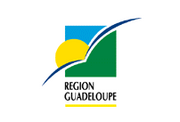 |
|
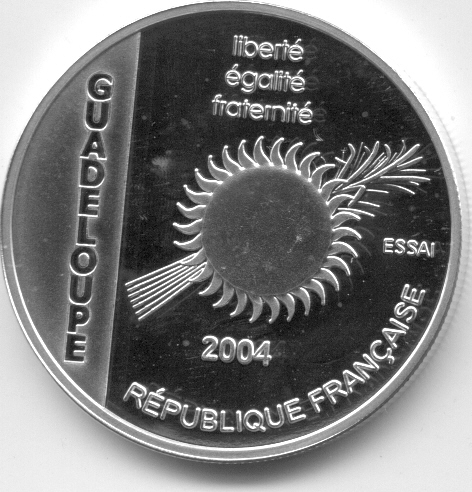 |
 |
|
It is French Overseas Department since 1946, an
archipelago located in the eastern Caribbean Sea at 16°15′N 61°35′W, with a
total area of 1,780 square kilometres (687 sq. mi). It is an overseas
département (département d'outre-mer, or DOM) of France. Like the other DOMs,
Guadeloupe is also one of the 26 régions of France (as a région d'outre-mer),
and an integral part of the Republic. As part of France, Guadeloupe is part
of the European Union, however not party to the Schengen Agreement.
Guadeloupe was populated from 300 BC by the Arawak Amerindians, who fished
and developed agriculture on the island. It was next inhabited by the Caribs,
who pushed out most of the Arawak in the 8th century, and who renamed the
island "Karukera" or the "Island of beautiful waters". During his second
trip to America Christopher Columbus became the first European to land on
Guadeloupe on 14 November 1493. He called it Santa María de Guadalupe de
Extremadura, after the image of the Virgin Mary venerated at the Spanish
monastery of Villuercas, in Guadalupe, Extremadura. The French took
possession of the island in 1635 and wiped out many of the Carib amerindians.
It was annexed to the kingdom of France in 1674. Over the next century, the
island was seized several times by the British. One indication of
Guadeloupe's prosperity at this time is that in the Treaty of Paris (1763),
France, defeated in war, accepted to abandon its territorial claims in
Canada in return for British recognition of French control of Guadeloupe. In
an effort to take advantage of the chaos ensuing from the French Revolution,
Britain attempted to seize Guadeloupe in 1794 and held it from April 21 to
June 2. The French retook the island under the command of Victor Hugues, who
succeeded in freeing the slaves. They revolted and turned on the
slave-owners who controlled the sugar plantations, but when American
interests were threatened, Napoleon sent a force to suppress the rebels and
reinstitute slavery. Louis Delgrès and a group of revolutionary soldiers
killed themselves on the slopes of the Matouba volcano when it became
obvious that the invading troops would take control of the island. The
occupation force killed approximately 10,000 Guadeloupeans in the process of
restoring order to the island. On February 4, 1810 the British once again seized the island and held it until March 3, 1813, when it was ceded to Sweden as a consequence of the Napoleonic Wars. Sweden already had a colony in the area, but merely a year later Sweden left the island to France in the Treaty of Paris of 1814. An ensuing settlement between Sweden and the British gave rise to the Guadeloupe Fund. French control of Guadeloupe was finally acknowledged in the Treaty of Vienna in 1815. Slavery was abolished on the island in 1848 at the initiative of Victor Schoelcher. Today the population of Guadeloupe is mostly of African origin with an important European and Indian active population. Lebanese, Chinese and people of many other origins are also present. Its major industries are tourism and making rum. The 1 1/2 Euro features the iron clad French warship La Glorie. The La Glorie, built in 1860, was the first iron clad warship. The Guadeloupe unofficial arms is on the obverse on the coin. |
|
| MARTINIQUE | |
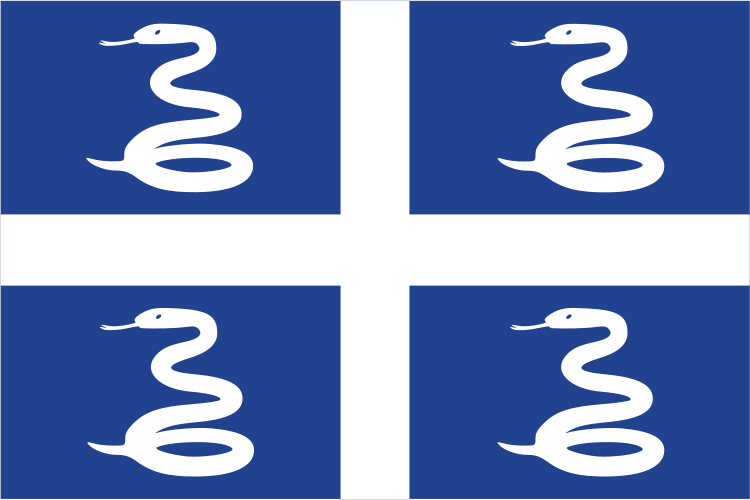 |
|
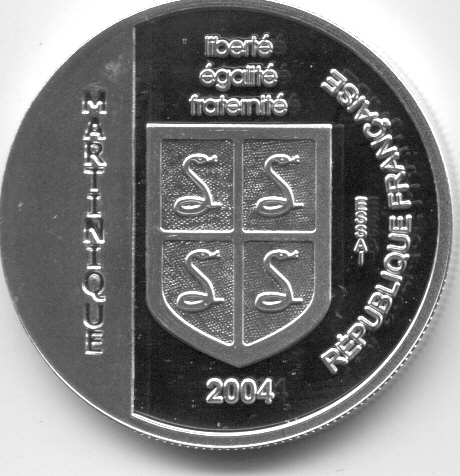 |
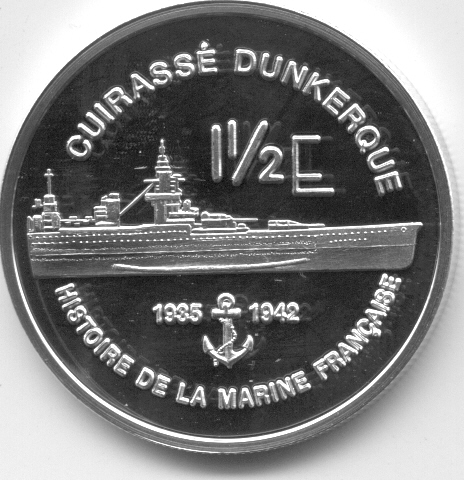 |
| It is French Overseas Department since 1946, an island in the eastern Caribbean Sea, having a total area of 1,128 km². It is an overseas département (département d'outre-mer, or DOM) of France. Like the other DOMs, Martinique is also one of the 26 régions of France (as a région d'outre-mer), and an integral part of the Republic. As part of France, Martinique is part of the European Union. Colonized by France in 1635, the Carib Expulsion occurred in 1660 when the island's indigenous peoples were deported and banned from returning by the French occupying forces. The island has subsequently remained a French possession except for three brief periods of foreign occupation. From 1635 (arrival of Pierre Belain d'Esnambuc, a French aristocrat who took possession of the island for France) to 1946, Martinique lived as a French colony producing tropical trade goods such as cane sugar, coffee, rum and cocoa. African captives were brought from West Africa to form the slave population that is the origin of most of today's population. In 1902, the volcano Mount Pelee exploded in a large pyroclastic explosion (named the Peleean Euruption after the volcano), sending a wall of ash and hot gases on the city of St. Pierre, killing 25,000 to 36,000 inhabitants (only one person, a criminal in the St. Pierre prison, survived). The 1 1/2 Euro features the World War II battleship Dunkerque. Her crew served bravely in the early years WWII. Both the British and the Germans attacked her before her crew scuttled her in November 1942 to prevent her capture by the Germans. The Martinique arms, featuring four snakes, is on the obverse of the coin. This coin has a reeded edge. | |
| MAYOTTE | |
 |
|
 |
 |
|
It is an overseas community of
France at the northern end of the Mozambique Channel in the Indian Ocean,
uses French flag and is between northern Madagascar and northern Mozambique.
The territory is geographically part of the Comoros islands, but not
politically. It is also known as Mahoré, especially by advocates of its
inclusion in the Union of Comoros. The main island, Grande-Terre (or Mahoré),
geologically the oldest of the Comoros, is 39 kilometres (24 mi) long and 22
kilometres (13½ mi) wide, and its highest points are between 500 and 600
meters (1,650–1,975 ft) above sea level. Because of the volcanic rock, the
soil is relatively rich in some areas. A coral reef encircling much of the
island ensures protection for ships and a habitat for fish. Dzaoudzi was the
capital of Comoros until 1977. It is situated on Petite-Terre (or Pamanzi),
which at 10 square kilometers (3.9 sq mi) is the largest of several islets
adjacent to Mahoré, to which it is linked by a causeway. Mayotte is a member
of the Indian Ocean Commission, with a separate membership rather than with
the Comoros. Circa 1500 the Maore or Mawuti (corrupted to Mayotte in French) sultanate was established on the island. In 1503 it was noted by Portuguese explorers, but not colonized. In 1832 it was conquered by Andriantsoly, former king of Iboina on Madagascar; in 1833 conquered by the neighbouring sultanate of Mwali (Mohéli island in French); on 19 November 1835 again conquered by Ndzuwani sultanate (Anjouan sultanate in French; a governor was installed with the unusual islamic style of Qadi, sort of a 'Resident Magistrate' in British terms), but in 1836 regained its independence under a last local Sultan. Mayotte was ceded to France along with the other Comoros in 1843. It was the only island in the archipelago that voted in referendums in 1974 and 1976 to retain its link with France and forgo independence (with 63.8% and 99.4% of votes respectively). The Comoros continue to claim the island, and a draft 1976 United Nations Security Council resolution supported by 14 of the 15 members of the Council would have recognized Comoros sovereignty over Mayotte, but France vetoed the resolution. The situation of Mayotte proved to be unwieldy for France: while the local population very largely did not want to be independent from France and join Comoros, some international criticism from both post-colonial and leftist regimes was heard about the ongoing ties of Mayotte to France. Furthermore, the peculiar local administration of Mayotte, largely ruled by customary Muslim law, would be difficult to integrate into the legal structures of France, not to mention the costs of bringing the standards of living to levels close to those of metropolitan France. Because of these reasons, the laws passed by the national parliament must state specifically that they apply to Mayotte for them to be applicable on Mayotte. The status of Mayotte was changed in 2001 towards one very close to the status of the départements of mainland France, with the particular designation of collectivité départementale, although the island is still claimed by the Comoros. This change was approved by 73% at a referendum on Mayotte. After the constitutional reform of 2003 it became a collectivité d'outre-mer while keeping to be entitled collectivité départementale de Mayotte. The battleship Bouvet is on the 1 1/2 Euro. In 1915 she hit a mine and sunk in within 2 minutes, with a loss of 660 men. The arms of Mayotte is on the obverse of the coin. The edge of the coin is lettered as .999 pure silver. |
|
| REUNION | |
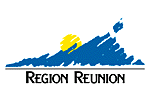 |
|
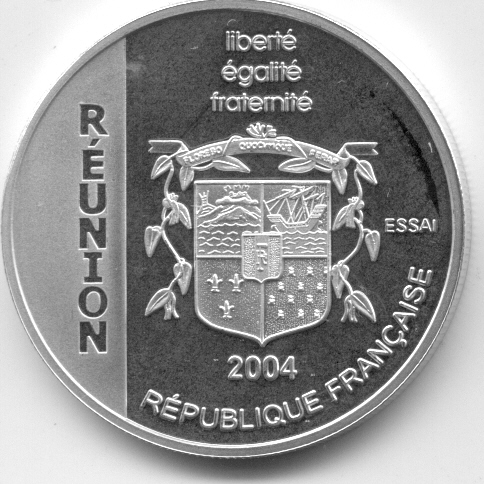 |
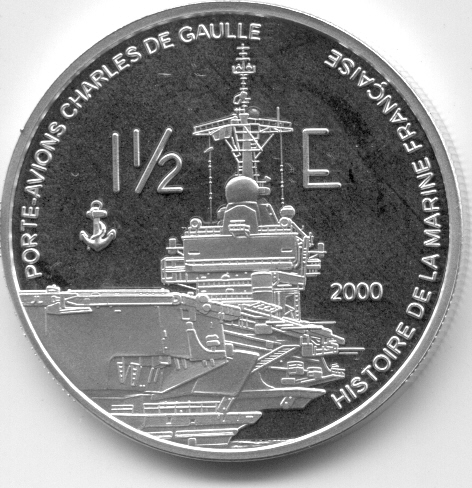 |
|
It is French Overseas Department since 19th
March 1946,
located in the Indian
ocean east of Madagascar, about 200 km southwest of Mauritius. Like the
other DOMs, Réunion is also one of the 26 régions of France with the same
status as those situated on the European mainland. As part of France,
Réunion is part of the European Union, and thus the currency used is the
euro (in fact, due to varying time zones in the European Union, Réunion was
the first region in the world to use the euro, and the first ever purchase
using the euro occurred at 12.01 a.m., when regional council president Paul
Vergés bought a bag of lychees at a Saint-Denis market).
Arab sailors used to call
this island Dina Morgabin ("Western Island").. The Portuguese
were the first Europeans to visit the
island, finding it uninhabited in 1513, and naming it Santa Apollonia. The
island was then occupied by the French and administered from Port-Louis,
Mauritius. Although the French flag was hoisted by François Cauche in 1638,
Santa Apollonia was officially claimed by Jacques Pronis of France in 1642,
when he deported a dozen French mutineers to the island from Madagascar. The
convicts were returned to France several years later, and in 1649, the King
of France Louis XIII named the island Île Bourbon after his royal house.
"Réunion" was the name given to the island in 1793 by a decree of the
Convention with the fall of the House of Bourbon in France, and the name
commemorates the union of revolutionaries from Marseille with the National
Guard in Paris, which took place on August 10, 1792. In 1801, the island was
renamed "Île Bonaparte," after Napoleon Bonaparte. The island was taken by
the British navy led by Commodore Josias Rowley in 1810, who used the old
name of "Bourbon." When it was restored to France by the Congress of Vienna
in 1815, the island retained the name of "Bourbon" until 1848, when the fall
of the restored Bourbons during the revolutions during that year meant that
the island became "Réunion" once again. |
|
| SAINT BARTHELEMY | |
 |
|
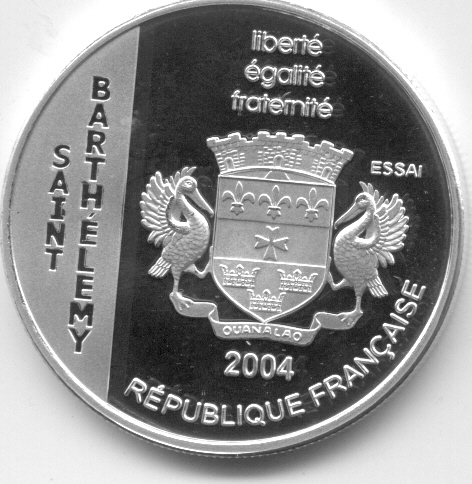 |
 |
|
Saint-Barthélemy is a French
island located in the Caribbean at 17°54′N 62°50′W, among the Leeward
Islands. Its land area is 21.0 km² (8.1 sq. miles). Administratively, the
whole island of Saint-Barthélémy is a French commune (commune de Saint-Barthélémy)
part of Guadeloupe, which is an overseas région and overseas département of
France, and therefore part of the European Union. The island is also known
as Saint Barts, Saint Barths, or Saint Barth. In 2003 the population voted
in favour of secession from Guadeloupe in order to form a separate overseas
collectivity of France. However Saint-Barthélémy currently remains part of
the région and département of Guadeloupe. St. Barts is perhaps best known
for being a vacation spot for the wealthy and famous. As a tourist
attraction, it is notable for its pristine beaches and well-respected
restaurants. Saint-Barthélemy was first claimed by France in 1648. It was sold to Sweden in 1785, which sold it back to France in 1878. The Swedish period made its marks by naming many of the streets and the town (in honour of king Gustav III) and leaving its national arm, the three crowns, in the St Barts coat of arm. Tourism is its main industry. The silver 1 1/2 Euro shows the Frigate Hermione, a sailing ship from the late 18th century. The arms of St. Barthlemy is on the obverse of the coin. The edge of the coin is lettered as .999 pure silver. The above shown flag is unofficial flag of Saint Barthélemy. |
|
| SAINT MARTIN | |
 |
|
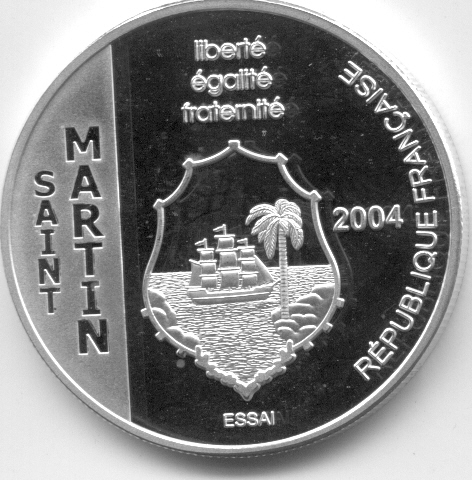 |
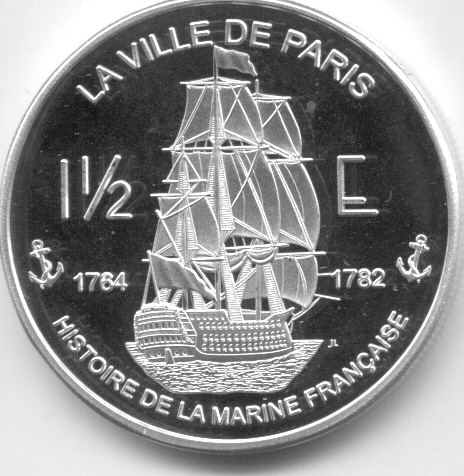 |
|
1493, Christopher
Columbus embarked on his second voyage to the New World. According to
legend, Columbus sighted and perhaps anchored at the island of Saint Martin
on November 11, 1493, the feast day of Saint Martin of Tours. In his honor,
Columbus named the island San Martin. It is now more commonly known as Sint
Maarten (Dutch), Saint-Martin (French), and Saint Martin (English).
When Columbus sailed
these seas, St. Martin was populated, if populated at all, by Arawak or
Carib Indians. The Arawaks were subjugated by the warlike Carib Indians from
South America a short time before the arrival of the Spanish who followed in
Columbus' wake. The English word cannibal is derived from an Arawak word
which referred to the Caribs. The Arawaks were a relatively cultured,
agricultural people who fashioned pottery and whose social organization was
headed by hereditary chieftains who derived their power from personal
deities called zemis. The Caribs, on the other hand, concentrated on
warfare. They killed and, allegedly, ate the Arawak men, then married the
Arawak women. Sint Maarten is
officially an "island territory" part of the Netherlands Antilles, which is
part of the Kingdom of the Netherlands though not in the European Union. Its
currency is the Antillean guilder (however, the United States dollar is
widely accepted). A proposed restructuring of the Netherlands Antilles would
see Sint Maarten become an independent component of the Kingdom of the
Netherlands in its own right. |
|
| SAINT PIERRE AND MIQUELON | |
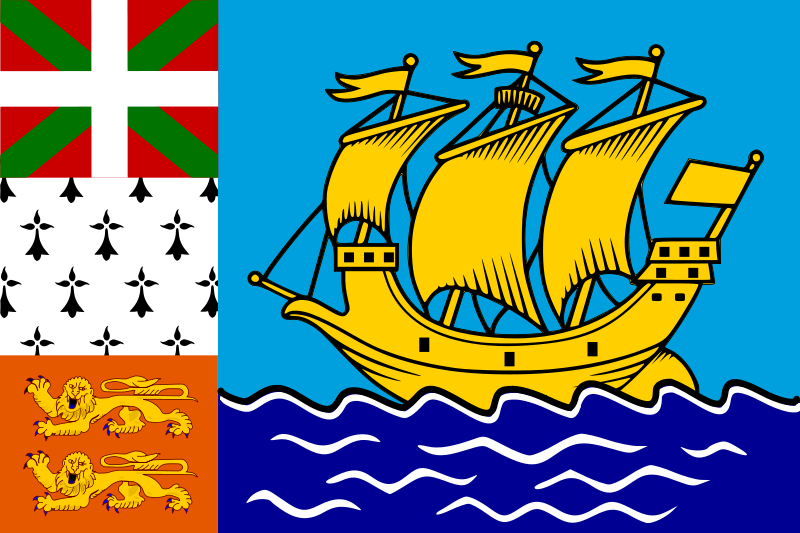 |
|
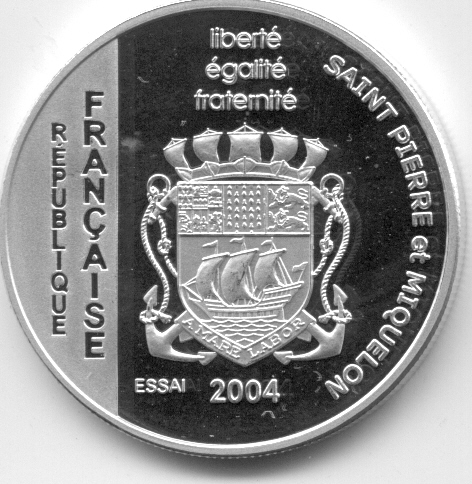 |
 |
|
Saint-Pierre and Miquelon
(French Saint-Pierre et Miquelon) 46°47′N 56°12′W is a French overseas
community consisting of several small islands off the eastern coast of
Canada near Newfoundland. It is the only remainder of the former colonial
territory of New France. Saint-Pierre and Miquelon has been under French
control since 1763. Paleoeskimo or Dorset culture artifacts have been
uncovered in Saint-Pierre (Anse à Henry). Some of these date back to 3000
BC. Named the 'Eleven Thousand Virgins' by Portuguese explorer João Álvares
Fagundes in 1521, the islands were also named the 'Islands of Saint-Pierre'
by the French. During the 16th century, the islands were used as a base for
the seasonal cod fishery by the French of La Rochelle, Granville, Saint-Malo
and the Basque Country. When French explorer Jacques Cartier was in
Saint-Pierre in 1536 he made note of the French and Breton fishery. The name Miquelon is of Basque origin as this island was used by fishermen from Saint-Jean de Luz. Saint-Pierre was settled by the French in the early 17th century, abandoned under the Treaty of Utrecht, and returned to France in 1763 at the end of the Seven Years' War. Between 1763 and 1778, the islands became a place of refuge for Acadian deportees from Nova Scotia. In 1778 the islands were attacked and the population deported by the British as retaliation for French support of the American Revolutionary War. Although France regained the islands in 1783, by 1793, British hostility to the French Revolution and the fact that France had declared war with the United Kingdom led to another British attack on the islands and the deportation of the entire population. The islands were finally returned to France after the second abdication of Napoleon in 1816. They represent the sole remaining vestige of France's once vast North American possessions. They have always been most important as a fishing centre, being in easy travelling distance of the Grand Banks of Newfoundland, some of the world's richest fishing grounds. The islands were used during American Prohibition as a base for smuggling liquor into the United States by many gangsters including Al Capone and Bill McCoy. After Nazi Germany invaded most of Europe during World War II, the islands were controlled by Vichy France. On Christmas Eve 1941, Free French forces led by Rear-Admiral Émile Muselier captured the islands on behalf of Charles de Gaulle. Saint-Pierre and Miquelon became the focus of a serious rift between Free French forces and the United States Department of State, which was courting Vichy France and threatened to send ships to take the islands back. The islands became a full département d'outre mer of France in 1976. This status was modified in 1985 and the islands became a territory with special status (collectivité territoriale à statut particulier). After the constitutional reform of 2003, it became a collectivité d'outre-mer, while keeping its particular name of collectivité territoriale de Saint-Pierre-et-Miquelon. The silver 1 1/2 Euro coin features the Free French Corvette Mimosa. The Mimosa was sunk by a German submarine in June 1942, with a loss of 58 French sailors, a majority of which came from St. Pierre and Miquelon. The loss of so many young men had a lasting effect on the small island community. The reverse has the arms of St. Pierre et Miquelon which features a three masted sailing ship. The edge of the coin is lettered as .999 pure silver. The above shown flag is unofficial flag of Saint Pierre and Miquelon. |
|
| Micro-Nations | |
| Chiefa Coins | |